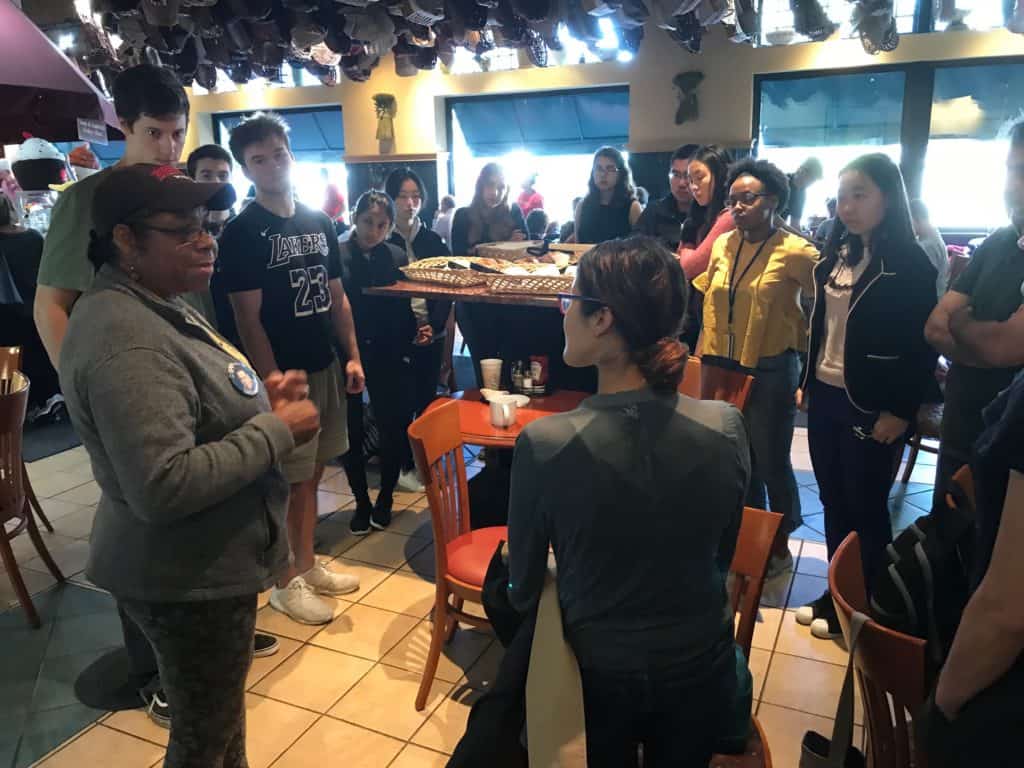For more than two decades, Trinity’s Cities Gateway Program—an integral part of the Center for Urban and Global Studies (CUGS)—has been connecting first-year students to the city of Hartford and other world cities. As an experiential-learning vehicle, the Cities Gateway Program offers an interactive orientation to introduce these students to their new home city. This fall, the Hartford orientation included a new urban focus and was led by a knowledgeable local expert, Jack Hale, a Trinity graduate from the Class of 1970.
Hale has been a proud resident of Hartford for the past 52 years, including his four years of study at Trinity. He served as the long-time executive director of Knox Foundation in Hartford and has remained active in the local community and religious life since his official retirement. On Saturday, September 16, Hale played the role of tour guide as he shared his deep intellectual and practical knowledge of all things Hartford. The daylong tour was intended to give the new Cities Gateway Program students—along with one new urban studies faculty member, one new postdoc fellow in urban studies, and two international visiting scholars from China and Turkey at CUGS—a taste of Hartford as a place to live and a laboratory for their studies. Hale said he hoped that the students and faculty would find something inspirational here in Hartford, that they would take full advantage of everything the city has to offer, and that they would find a way to contribute to the city and its residents while they are here.

The group started the tour with a breakfast meeting with the president of the Maple Avenue Neighborhood Revitalization Zone (NRZ), Hyacinth Yennie P’02, ’06, at First & Last Bakery. Yennie spoke with the students about getting connected and involved with Hartford. After winding through the south end of the city, the bus took the group to Coltsville, the neighborhood that developed around Sam and Elizabeth Colt’s gun factory. The area will soon be home to a national park interpreting the development of precision manufacturing in the Connecticut River Valley and the remarkable stories of the Colts’ contributions to marketing, manufacturing, philanthropy, and civic engagement. Stops included the Church of the Good Shepherd, commissioned by Elizabeth Colt in memory of her husband and of their three children who died in infancy, and the eccentric Colt Memorial Parish House, which tells the story of the Colts’ only child to survive into adulthood. The art, architecture, family history, and connection to industrial development are all illustrated at these iconic sites, whose lasting cultural legacies continue to teach about both change and continuity in American cities.
Lunch at Brazil Grill in Parkville may well have been the high point of the day, as students and faculty enjoyed a wonderful cuisine that was unfamiliar to many. The ethnicities and national origins of Hartford’s citizens are well represented in the city’s diverse restaurants. The tour passed Polish, Jamaican, Puerto Rican, Thai, Colombian, Italian, Portuguese, and Dominican eateries, among others. This “taste” hopefully will inspire these newcomers to seek out more culinary adventures and to appreciate the diversity of the people who provide them.
Written by Jack Hale ’70 and Xiangming Chen, Paul E. Raether Distinguished Professor of Global Urban Studies and Sociology and Dean and Director of CUGS and the Cities Gateway Program
Both photos by Xiangming Chen
Header photo: Jack Hale ’70 talks about the history of Coltsville to the Cities Gateway Program students.
